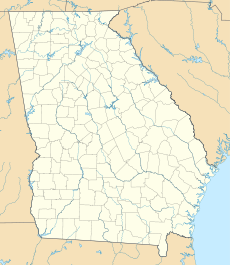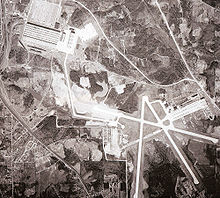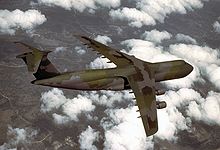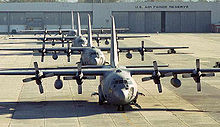- Dobbins Air Reserve Base
-
Dobbins Air Reserve Base Part of Air Force Reserve Command (AFRC) Located near: Marietta, Georgia 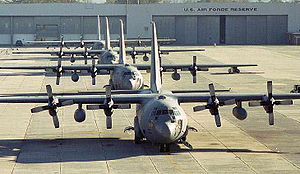
C-130s on the flightline - Dobbins AFB, GeorgiaCoordinates 33°54′55″N 084°30′59″W / 33.91528°N 84.51639°W Built 1941 In use 1942-Present Controlled by  United States Air Force
United States Air ForceGarrison 
94th Airlift WingAirfield information IATA: MGE – ICAO: KMGE – FAA LID: MGE Summary Elevation AMSL 1,068 ft / 326 m Website Runways Direction Length Surface ft m 11/29 10,000 3,048 Concrete 110/290 3,500UNIQ3bb62c98,390,000fb-ref-00,000,000-QINU 1,067 Asphalt Dobbins Air Reserve Base or Dobbins ARB (IATA: MGE, ICAO: KMGE, FAA LID: MGE) is a United States air reserve base located in Marietta, Georgia, a suburb about 20 miles (32 km) northwest of Atlanta. It was named in honor of Captain Charles M. Dobbins, a World War II C-47 pilot who died near Sicily. It serves as the home station of the 94th Airlift Wing and its fleet of Hercules C-130 aircraft, and is the headquarters for Twenty-Second Air Force. It is also home to the Army Aviation Service Facility #2 (AASF#2), the Georgia Army National Guard and their fleet of UH-60 Blackhawks. Dobbins is also home to Marine and Navy Reserve units.
Dobbins ARB has two runways which it shares with Naval Air Station Atlanta (NAS Atlanta) to its south. 11-29 is the primary runway and it is 10,000 feet (3,000 m) long and 300 feet (91 m) wide with directions 110 and 290. The second runway, called an "assault strip", is a 3500×60-foot (1067×18-meter) runway referred to as 110-290, which is parallel to 11-29.
Contents
Units
The 94th Airlift Wing is the host unit at Dobbins ARB supporting all agencies and tenants at Dobbins Air Reserve Base. To accomplish this, the wing recruits, organizes, and trains Air Force Reservists for active duty in time of war, national emergency, or contingency tasking.
It is organized into a headquarters element, three groups, and a medical element containing 11 Squadrons and 4 Flights (1,800 personnel).
The primary mission of the Wing is to train C-130H aircrews for the United States Air Force -- active duty, guard and reserve components. Our second mission is to maintain combat ready units to deploy on short notice to support contingencies anywhere in the world. The aircrews we train are capable of using the C-130H aircraft to deliver cargo and personnel into and out of airports as minimal as dirt runways to international airports.
History
War years
Originally intended by Cobb County as an alternative airfield for Atlanta's Candler Field, this airfield was constructed in 1941 as Rickenbacker Field. This was named for the former U.S. Army Air Corps top flying ace of World War I, Captain Eddie Rickenbacker
The push to build this airport came in 1940 when President Franklin D. Roosevelt selected General Lucius D. Clay of the Army Air Corps to be the chief of the new Civil Aeronautics Administration (CAA), which was engaged in a huge program of airfield construction. About 450 to 500 of these were built in preparation for any possible war against the United States - from the east (Nazi Germany and Fascist Italy) or from the west (the Empire of Japan).
In 1940, the CAA offered to build a modern paved airport in Cobb County if the local governments provided the land. Due to the potential labor force for defense factories in this area, local officials also hoped to attract a large aircraft aircraft factory adjacent to the site. On October 24, the government of Cobb County announced the existence of this airport project, and it also revealed that purchase options had been signed for three prospective sites. The Atlanta City Council also passed a resolution endorsing this project on January 2, 1941. Since the Army Air Corps had recently taken over part of Candler Field, the principal municipal airport for Atlanta, the new airport in Cobb County was also seen as a reliever airport for Atlanta.
In May, the local government issued bonds to purchase 563 acres (2.28 km2) located 3½ miles southeast of Marietta along the western side of the new four-lane superhighway, U.S. Highway 41, linking Marietta with Atlanta. The CAA next allocated $400,000 for construction of two 4,000-foot (1,200 m)-long runways on the land. The W. L. Florence Company of Powder Springs, Georgia, the low bidder with a bid of $290,000, won the contract. This bid, well-below the estimated cost of $400,000, allowed the CAA to add the third runway to this construction project. The construction began on 14 July 1941. In the next month, the Gulf Oil Corporation and Georgia Air Services agreed to lease the airport, once completed, for $12,000 per year. In September 1941, Eddie Rickenbacker, America's leading flying ace of World War I, and then the president and general manager of Eastern Airlines, agreed to have this airport named Rickenbacker Field in his honor. In the same month, the U.S. Navy requested permission to use this airport for the flight training of Naval aviators purposes. (The Navy had established the "Naval Aviation Reserve Base Atlanta", at what is now the DeKalb-Peachtree Airport, in March 1941.) In October, Georgia Air Services signed a $70,000 contract for two 180x160-ft. airplane hangars to be built. Although it was far from completion, the dedication of this airfield took place in October 1941
After the Japanese Attack on Pearl Harbor, work on this new airfield accelerated rapidly. In January 1942, Lawrence Dale Bell, the founder and president of the Bell Aircraft Company, inspected this site for a proposed government-financed airplane factory for the Department of War. Meanwhile, the Department of the Navy announced its intention to take over the new airfield as an auxiliary naval air station. The Navy shortly began land-condemnation proceedings.
The Department of War, in turn, announced that it would not contest the wish of the Department of the Navy to take over Rickenbacker Field, and that it would build its new factory elsewhere. The Cobb County government appealed to the Secretary of the Navy, Frank Knox, urging him to change the Navy's plans. Since other options were available for flight training. Secretary Knox relinquished the Navy's claim on this airfield and left it to the Army Air Forces. (During World War II, the Navy established an auxiliary naval air station at Gainesville, Ga., just northeast of Atlanta.)
On January 23, 1942, the Bell Aircraft Company and the Department of War announced that an aircraft factory employing up to 40,000 workers would be built near Marietta. Also, the Department of War announced on February 19 that "Rickenbacker Field" would be renamed the Marietta Army Airfield. Although its construction began in March 1942, its official ground-breaking ceremony took place in May 1942, with Capt. Rickenbacker present. Rickenbacker went on to establish and pay for an aviation educational program to train workers for both civil aviation and military aviation. Also in 1942, the City of Atlanta began work on its contribution: a million pipeling pipeline to supply the new factory with water from the Chattahoochee River.
In addition to taking over Rickenbacker Field, the U.S. Army Air Forces (USAAF) purchased a parcel of land just north of the airfield for a cantonment area. The Marietta Army Airfield was activated on June 6, 1943, with its personnel housed in tents as part of the 58th Bombardment Operational Training Wing. At the end of June 1943, there were 42 officers and 356 men stationed here.
The mission of the Marietta Army Airfield was acceptance testing of B-29 Superfortress heavy bombers for the USAAF, the modification of B-29s, and the operation of an Army Air Depot. Barracks for the soldiers reached completion in November 1943. By January 1, 1944, the number of soldiers stationed here had risen to 73 officers and 1,263 enlisted men. For a period of time, the Marietta Army Airfield was assigned to the USAAF's Second Air Force under the XX Bomber Command. On 12 April 1944, the Marietta Army Airfield was reassigned to the "17th Bombardment Operation Training Unit".
In the spring of 1943 the adjacent Bell Aircraft Company's factory, an additional plant (besides a pair of Boeing plants at Renton, Washington and Wichita, Kansas and a Martin plant at Omaha, Nebraska[2][3]) for manufacturing B-29 Superfortresses was completed. The "Defense Plant Corporation" of the Department of War paid for the construction of this factory, and the Department called it "Plant #6". Bell Aircraft completed its first B-29 on schedule, and this was first test-flown on November 4, 1943. The production of B-29s at this factory increased slowly during 1944, and by the fall of 1944, Bell Aircraft's output of new B-29s began to meet and exceed the goals of the Department of War.
By January 1945, Bell Aircraft had completed 357 B-29As. After the complettion of the last one of these, the production in Marietta was switched to the B-29B Superfortress, which was a simplified version of the B-29 without the computerized gun system and other components that raised the allowable bomb load from 11,000 to 18,000 pounds. The new B-29B radar, mounted in a wing-shaped radome under the fuselage, gave much better images of the ground. The 315th Bombardment Wing based at Northwest Field, Guam, received most of the B-29Bs for night low altitude pathfinder led missions against Japan. Bell built a total of 311 B-29Bs before the plant closed in January 1946. At its height, the Bell Bomber plant employed 28,263.
Post-war
Marietta Army Airfield remained open after the war and became the home of Georgia Air National Guard (ANG) and Air Force Reserve units. The first post¬war ANG unit, the 128th Fighter Squadron, activated at Marietta on 20 August 1946, with P-47 Thunderbolts. This was followed by the activation of the headquarters of the 116th Fighter Group on 9 September and the activation of the headquarters of the 54th Fighter Wing which commanded 56 units of the Air National Guard throughout the Southeastern states.
In 1948, part of the land and barracks at the original Naval Air Station Atlanta in Chamblee were given to the state for the purpose of creating an engineering technology school that could rapidly train returning soldiers for civilian work in various technical fields.
In 1948 the airfield became Marietta Air Force Base as a result of the creation of the United States Air Force. In 1950, the Air Force renamed the base Dobbins Air Force Base in honor of Captain Charles M. Dobbins of Marietta, a World War II transport pilot. Captain Dobbins died near Sicily on July 11, 1943 when US Navy gunners who had earlier suffered a Luftwaffe attack mistakenly downed his C-47. He was flying his third mission of the day, dropping paratroopers.
In 1949, the Georgia Institute of Technology in Atlanta created the Southern Technical Institute (now Southern Polytechnic State University), which was moved to land given by Dobbins AFB in 1958.
Following the war, the Bell Aircraft Plant #6 remained closed for five years. In 1951, Lockheed Aircraft Corporation took over the plant to modify B-29s for the Korean War. Lockheed Marietta also went on to build 394 B-47 Stratojets at the plant under license from Boeing. Additionally, Lockheed also conducted a B-47 modification program at Marietta. To handle the B-47 production and modification work, the airfield received a 10,000 × 300 ft (91 m) runway. Over the years, the Lockheed plant constructed the Lockheed JetStar business jet (C-140), C-130 Hercules, C-141 Starlifter, and C-5 Galaxy.
In 1957, the Atlanta Naval Air Station at Peachtree-DeKalb Airport in Chamblee moved to Dobbins. The Navy constructed a cantonment area on the southwest portion of Dobbins for their use.
Over the years, a wide variety of Air Force aircraft have been stationed at Dobbins with the Air Guard and Reserves including the P-51, F-84, F-86, C-97,C-123, C-124, F-100, F-4, C-130, and the F-15.
Current and future
The future of Plant #6 seems secure. In 1995, Lockheed merged with Martin Marietta to become Lockheed-Martin. The C-130 Hercules remains in production 50 years after the first one rolled out in 1955. Work also continues on the F-22 Raptor and the Joint Strike Fighter. Dobbins has its own ZIP code, 30069, and Lockheed also has its own ZIP code, 30063. (However, Marietta is the only place name considered acceptable by the USPS for either of these.)
Dobbins is also an automated weather station, reporting five minutes before every hour. Until sometime in 2008, it only reported from 7am to 11pm (6:55 to 10:55/22:55), although it occasionally reported overnight during unusual weather conditions, such as strong winds due to the 2004 hurricanes (Frances, Jeanne, Ivan). Local conditions shown on The Weather Channel and Weatherscan are now taken from a different system setup by TWC during the mid-2000s; until then, overnight conditions for local cable TV systems came from Fulton County Airport.
Like most U.S. bases, Dobbins has had to fend off several attempts at closing it, as part of streamlining the country's military and reducing unnecessary spending. Development has steadily encroached upon the base since the war. 1989 A-7 Corsair II and 1993 C-130 Hercules plane crashes into residential areas near the base raised questions of safety in having a base in such a densely-populated suburban area. The airfield now sits in a vast sea of urban development, Flying demonstrations at air shows were discontinued some years ago because of safety concerns, although the Navy hosted air shows in 2004 and 2006, and the ARB side hosted air shows in 2008 and 2010 (2008 marked the first time in over 15 years of a USAF Thunderbirds performance at KMGE).
Public complaints about the noise continue, and attempts to close the facility have been thwarted so far by powerful local politicians, such as former U.S. Senator Sam Nunn in 1995. However, some have proposed that it again become a commercial airport, as it was originally envisioned (there have been calls for Dobbins to become the second major commercial airport in metro Atlanta, to be a major reliever to Hartsfield–Jackson Atlanta International Airport, one of the busiest airports in the United States).
Dobbins is the only U.S. military facility left in northern Georgia after 2005 BRAC recommendations were enacted. The Air National Guard transferred to Robins AFB in 1996, leaving Air Force Reserve C-130s as the only Air Force flying units at the base. The 148th Medical Company (Air Ambulance), 151st Aviation, and 171st Aviation units of the Army National Guard are also based there. More units are moving to Dobbins as the Georgia Army National Guard takes over NAS Atlanta.
In 2003, the Air Force Reserve Command changed the name of Dobbins Air Reserve Base to that of Dobbins Joint Air Reserve Base.[4]
In September 2005, the 53rd Weather Reconnaissance Squadron Hurricane Hunter aircraft flew out of Dobbins after Hurricane Katrina did major damage to their normal home at Keesler Air Force Base in Biloxi, Mississippi. Numerous evacuees also came to metro Atlanta through Dobbins, including many medevaced medical patients taken in by local hospitals.
Until the late 20th century, the oldest building on base was part of the Lockheed complex, and was built before the American Civil War. Legend has it that the only reason the building wasn't burned to the ground during Union General William Tecumseh Sherman's "March to the Sea" in 1864 was because the building's owner, a British citizen, had flown the British flag during the occupation of Marietta, part of the Atlanta Campaign.
Near Dobbins' main gate stands a Wichita built B-29 "Sweet Eloise" (B-29-80-BW 44-70113) which is on public display as a memorial to World War II bomber production plant at the site. However, at least two Marietta-built B-29s have survived the years. One is on display at the Georgia Veterans Memorial State Park near Cordele (B-29A-15-BN 42-93967) and the other (B-29B-55-BA 44-84053) is located at Robins Air Force Base' Museum of Flight near Macon.
Major Commands to which assigned
- AAF Air Service Command, October 13, 1942
- Commanding General, Army Air Forces, September 27, 1943
- Second Air Force, January 14, 1944
- AAF Materiel Command, July 15, 1944
- AAF Materiel and Services, July 17, 1944
- Redesignated: AAF Technical Service Command, August 31, 1944
- Air Technical Service Command, July 1, 1945
- Air Materiel Command, March 9, 1946
- Air Defense Command, June 25, 1946
- Continental Air Command, May 10, 1949
- Air Force Reserve, August 1, 1968
- Redesignated: Air Force Reserve Command, February 17, 1997–present
Major Units assigned
- 522d Base HQ and Air Base Squadron, June 10, 1943 – March 25, 1944
- 292d Army Air Force Base Unit, March 25, 1944 – May 31, 1946
- 54th Fighter (later Troop Carrier) Wing, October 2, 1946 – October 11, 1950
- 4204th Army Air Force (later Air Force) Base Unit, May 31, 1946 – December 14, 1958
- 94th Bombardment Group, May 29, 1947 – March 20, 1951
- Established as: 94th Bombardment (later Tactical Reconnaissance) Wing, June 26, 1949 – May 18, 1955
- 514th Troop Carrier Group, May 29, 1947 – June 26, 1949
- 35th Air Division, September 4, 1951 – November 15, 1958
- 902d Reserve Training Wing, December 19, 1951 – June 13, 1952
- 116th Tactical Fighter Wing (Various Designations), July 10, 1952 – 1996
- 2589th Air Reserve Combat Training Center, November 1, 1953 – December 27, 1961
- 445th Troop Carrier Wing (Various Designations), September 6, 1957 – June 29, 1971
- 918th Troop Carrier Group (Various Designations), January 15, 1963 – September 1, 1975
- 94th Tactical Airlift Wing (Various Designations), July 1, 1972 – Present
- Fourteenth Air Force, October 8, 1976 – July 1, 1993
See also
- Georgia World War II Army Airfields
- Air Technical Service Command
- Central Air Defense Force (Air Defense Command)
References
 This article incorporates public domain material from websites or documents of the Air Force Historical Research Agency.
This article incorporates public domain material from websites or documents of the Air Force Historical Research Agency.
- ^ FAA Airport Diagram (PDF), effective 20 October 2011
- ^ Bowers 1989, p.319.
- ^ Bowers 1989, p.322.
- ^ Dobbins Air Reserve Base at GlobalSecurity.org
 This article incorporates public domain material from the United States Government document "Dobbins Air Reserve Base".
This article incorporates public domain material from the United States Government document "Dobbins Air Reserve Base".- Maurer, Maurer (1983). Air Force Combat Units Of World War II. Maxwell AFB, Alabama: Office of Air Force History. ISBN 0892010924.
- Mauer, Mauer (1969), Combat Squadrons of the Air Force, World War II, Air Force Historical Studies Office, Maxwell AFB, Alabama. ISBN 0892010975
- Shettle, M. L. (2005), Georgia's Army Airfields of World War II. ISBN 0-9643388-3-1
External links
- Georgia Encyclopedia article
- Unofficial site for 1/171 AVN REGT, GA National Guard
- FAA Airport Diagram (PDF), effective 20 October 2011
- FAA Terminal Procedures for MGE, effective 20 October 2011
- Resources for this U.S. military airport:
- AirNav airport information for KMGE
- ASN accident history for MGE
- NOAA/NWS latest weather observations
- SkyVector aeronautical chart for KMGE
 Air Force Reserve Command (AFRC)
Air Force Reserve Command (AFRC)Air Forces 
Bases Dobbins • Duke Field • General Mitchell • Grissom • Homestead • March • Minneapolis-Saint Paul • Niagara Falls • Pittsburgh • Westover • YoungstownCommand Air Reserve Personnel CenterWings/Groups Air RefuelingAirliftFighterother310th Space • 349th Air Mobility • 403d • 452d Air Mobility • 514th Air Mobility • 307th Bomb • 919th Special Operations • 920th RescueBases CONUSAdair · Beale · Bong (unbuilt) · Charleston · Davis-Monthan · Dobbins · Dover · Dow · Duluth · England · Ent · Ethan Allen · Fairfax · Fort Lee · Geiger · George · Glasgow · Grand Forks · Grenier · Griffiss · Gunter · Hamilton · Hancock · Homestead · Hurlburt · Imeson · K.I. Sawyer · Kincheloe · Kingsley · Kirtland · Larson · Luke · March · Malmstrom · McCoy · McChord · McClellan · McGhee Tyson · McGuire · Minneapolis-St. Paul · Minot · Mitchel · New Castle · Niagara Falls · Norton · O'Hare · Oklahoma City · Otis · Oxnard · Paine · Perrin · Peterson · Pittsburgh · Pope · Portland · Presque Isle · Richards-Gebaur · Selfridge · Seymour Johnson · Sioux City · Snelling · Stead · Stewart · Suffolk County · Tinker · Travis · Truax · Tyndall · Vandenburg · Webb · Westover · Willow Run · Wright-Patterson · Wurtsmith · Youngstown
OverseasErnest Harmon · Frobisher Bay · Goose Bay · Keflavik · Pepperrell · Thule · Topsham

Stations CONUSAlmaden · Charleston · Clear · Cross City · Benton · Empire · Mill Valley · Montauk · Mount Hebo · North Truro · Point Arena · Rye · Thomasville · Watertown
OverseasAlbrook
Air
Defense
unitsForcesAir
DivisionsSectorsAlbuquerque · Bangor · Boston · Chicago · Detroit · Duluth · Goose · Grand Forks · Great Falls · Iceland · Kansas City · Los Angeles · Minot · Montgomery · New York · Oklahoma City · Phoenix · Portland · Reno · Sault Sainte Marie · San Francisco · Seattle · Sioux City · Spokane · Stewart · Syracuse · Washington
WingsGroups1st · 4th · 10th · 14th · 15th · 23rd · 32nd · 33rd · 50th · 52nd · 53rd · 54th · 56th · 57th · 73rd · 78th · 79th · 81st · 82nd · 84th · 325th · 326th · 327th · 328th · 329th · 337th · 355th · 408th · 412th · 414th · 473rd · 475th · 476th · 478th · 500th · 501st · 502d · 503d · 507th · 514th · 515th · 516th · 517th · 518th · 519th · 520th · 521st · 525th · 527th · 528th · 529th · 530th · 533d · 534th · 564th · 566th · 567th · 568th · 575th · 678th · 701st · 4676th · 4700th · 4721st · 4722d · 4727th · 4728th · 4729th · 4730th · 4731st · 4732d · 4733d · 4734th · 4735th · 4756th
SquadronsAerospace Defense Command Fighter Squadrons · Aircraft Control and Warning Squadrons
Major
weapon
systemsElectronicFightersMissiles1 · 2 · 3 · 4 · 5
ShipsGuardian · Interceptor · Interdictor · Interpreter · Investigator · Locator · Lookout · Outpost · Pickett · Protector · Scanner · Searcher · Skywatcher · Tracer · Watchman · Vigil
Miscellaneous Air Defense Command Emblem Gallery (On Wikimedia Commons) · General Surveillance Radar Stations USAAF Second Air Force in World War II
USAAF Second Air Force in World War IIAirfields Group Training Stations · Heavy Bombardment Training Stations · Replacement Training Stations · Tactical Airfields · Very Heavy Bomber Bases
Units Commands II Air Support Command · II Bomber Command · II Fighter Command · IV Air Support Command · XX Bomber Command · XXI Bomber Command · XXII Bomber CommandWings 5th Bombardment · 15th Bombardment Training · 16th Bombardment Operational Training · 17th Bombardment Training · 18th Replacement · 21st Bombardment · 46th Bombardment Operational Training · 58th Bombardment · 73d Bombardment · 315th Bombardment · 316th BombardmentGroups Bombardment 2d Bombardment · 6th Bombardment · 7th Bombardment · 9th Bombardment · 12th Bombardment · 16th Bombardment · 17th Bombardment · 19th Bombardment · 25th Bombardment · 29th Bombardment · 34th Bombardment · 39th Bombardment · 40th Bombardment · 42d Bombardment · 46th Bombardment · 47th Bombardment · 48th Bombardment · 85th Bombardment · 86th Bombardment · 86th Bombardment · 88th Bombardment · 94th Bombardment · 95th Bombardment · 96th Bombardment · 99th Bombardment · 100th Bombardment · 301st Bombardment · 302d Bombardment · 303d Bombardment · 304th Bombardment · 305th Bombardment · 306th Bombardment · 307th Bombardment · 308th Bombardment · 312th Bombardment · 330th Bombardment · 331st Bombardment · 333d Bombardment · 346th Bombardment · 351st Bombardment · 376th Bombardment · 379th Bombardment · 381st Bombardment · 382d Bombardment · 383d Bombardment · 384th Bombardment · 385th Bombardment · 388th Bombardment · 390th Bombardment · 393d Bombardment · 395th Bombardment · 396th Bombardment · 398th Bombardment · 399th Bombardment · 400th Bombardment · 401st Bombardment · 407th Bombardment · 415th Bombardment · 418th Bombardment · 444th Bombardment · 445th Bombardment · 446th Bombardment · 447th Bombardment · 448th Bombardment · 449th Bombardment · 450th Bombardment · 451st Bombardment · 452d Bombardment · 453d Bombardment · 454th Bombardment · 455th Bombardment · 456th Bombardment · 457th Bombardment · 458th Bombardment · 459th Bombardment · 460th Bombardment · 461st Bombardment · 462d Bombardment · 464th Bombardment · 467th Bombardment · 468th Bombardment · 469th Bombardment · 470th Bombardment · 471st Bombardment · 472d Bombardment · 484th Bombardment · 485th Bombardment · 486th Bombardment · 487th Bombardment · 488th Bombardment · 489th Bombardment · 490th Bombardment · 491st Bombardment · 493d Bombardment · 494th Bombardment · 497th Bombardment · 498th Bombardment · 499th Bombardment · 500th Bombardment · 501st Bombardment · 502d Bombardment · 504th Bombardment · 505th Bombardment · 509th CompositeFighter Reconnaissance 2d Reconnaissance · 3d Reconnaissance · 4th Reconnaissance · 5th Reconnaissance · 6th Reconnaissance · 7th Reconnaissance · 8th Reconnaissance · 71st Reconnaissance · 77th ReconnaissanceTroop Carrier 443d Troop CarrierAirports of metro Atlanta Commercial Hartsfield–Jackson Atlanta International Airport (ATL)General aviation Cobb County Airport (RYY) • Cherokee County Airport (CNI) • Clayton County Airport (4A7) • Cartersville Airport (VPC) • Gwinnett County Airport (LZU) • Newnan-Coweta County Airport (CCO) • DeKalb-Peachtree Airport (PDK) • Fulton County Airport (FTY) • Paulding County Regional Airport (PUJ) • Falcon Field (FFC)Military Naval Air Station Atlanta and Dobbins Air Reserve Base (MGE)Private Mathis Airport (GA27)Closed Stone Mountain Airport (00A)Categories:- Airports in Georgia (U.S. state)
- Airfields of the United States Army Air Forces in Georgia (U.S. state)
- Airfields of the United States Army Air Forces Technical Service Command
- Bases of the United States Air Force
- Buildings and structures in Cobb County, Georgia
- Lockheed Martin associated military facilities
- Military facilities in Georgia (U.S. state)
- United States Air Force Reserves
- Transportation in Cobb County, Georgia
Wikimedia Foundation. 2010.

